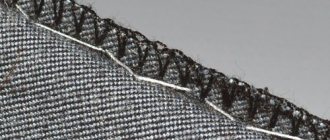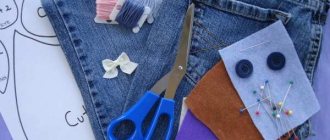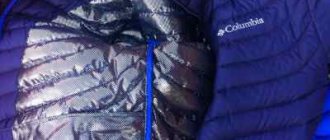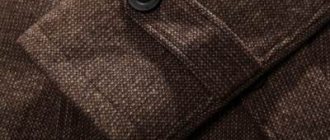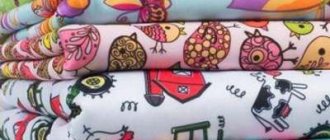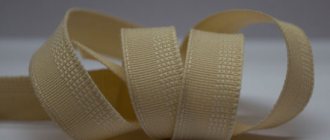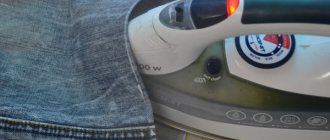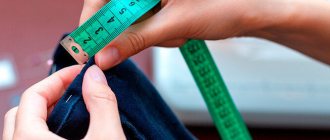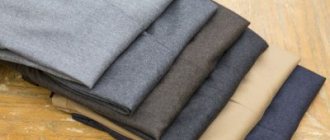Hemming trousers or sewing the hem of a skirt by hand is not always as easy as it seems. In the atelier, classic men's or women's trousers are hemmed on a special machine. Instead of thread, transparent thread (monofilament) is often used, so the hemming seam is not visible from the front side.
The hem of the bottom of men's trousers is first overlocked using an overlocker, then the trouser tape is sewn on with two lines using a machine. For women's trousers, braid is not used. Sometimes, depending on the type of fabric and model of trousers, a finishing stitch is used instead of a hidden hem stitch. Basically, this treatment is used to secure the hems of knitted and children's trousers.
In this video you will learn how to hem men's trousers with trouser tape on a sewing machine. The hem of the trousers is secured with a hidden hand stitch.
At home, trousers must be hemmed manually using a hidden seam. In most cases, you can even fix the hem with a web, but be sure to duplicate it with a hidden stitch. In any case, it is advisable to know some of the features of this technology in order to hem trousers correctly and beautifully. How to hem trousers so that the seam does not “pull” and the hand-stitched threads do not come out on the front side, the tape does not “fray”, etc. Check with a professional tailor for recommendations.
Flower nursery Green Gate
Do you like indoor or garden flowers? At the Green Gate nursery you can buy rooted cuttings and divisions of various domestic and perennial garden flowers. We have a constantly updated collection of anthuriums and hibiscus. Flowers and plants are sent by mail.
How to hem tapered trousers
If you've already had to hem trousers with your own hands, then you've probably noticed that hemming the bottom of trousers is often a bit of a hassle. The fact is that the diameter of the trouser leg at the very bottom is smaller than the area where the seam is laid. This will be especially noticeable when finishing machine stitching is used instead of a hidden seam. By the way, the hem for men's trousers should be at least 4 cm, and for women's trousers - 3 cm. To prevent this from happening, you need to unravel both seams of the trouser leg from the bottom by 4 cm (the width of the hem) and stitch them again from this point, but reduce the allowance to the bottom to the minimum value. In this case, the diameter of the leg at the bottom will increase, and the hand-blind seam will no longer tighten the hem. Not all trousers need to do this. As a rule, such a discrepancy occurs in women's, very tapered trousers. You don't need to do this for a skirt either.
Velvet pants
Loose-fitting trousers, as well as tapered models, are made from corduroy. The length of the second option is subject to the same requirements that we have already considered earlier. As for wide corduroy trousers, their trouser leg should reach the middle of the heel and cover the shoes, right up to the edge of the lacing.
The main difference between cargo and other trousers is the presence of patch pockets on the buttocks and legs. The length of these models should be optimal to reach the shoes. In this case, the trouser leg, as a rule, lies slightly on it, without forming folds, but also without sinking to the floor.
How to sew trouser tape on a sewing machine
I won't talk about how to straighten and cut pants. You can learn more about this in the article How to Hem Jeans. I’d rather dwell in more detail on the “nuances” of the technology, since the entire result of your work will often depend on these little things.
So, how to sew a trouser tape on a sewing machine. It would seem that there is nothing complicated, just carefully stitch the tape in two lines and do not forget to tuck the edge of the tape at the place where it joins. You should not tuck the tape, since the joining seam will become quite rough. In men's trousers made of thick fabric this may not be very noticeable, but on light fabrics the hem will stand out like a stick. It is best to singe the cut section of the trouser braid with matches and overlap it. Trouser tape is usually synthetic and melts very well.
When adjusting the tape, you need to accurately align its edge with the hem line marked in chalk. Moreover, the top line, which will become the bottom line when finished, must be sewn exactly 0.1 mm from the edge of the tape. No more and no less. In the finished product, the tape should “peek out” a little to protect the trousers from rubbing along the hem seam. By the way, the color of the ribbon should be matched to the color of the main fabric of the trousers.
Also, when adjusting the tape, do not tighten it. If you pull the tape, the pants at the bottom will be very narrow. If, on the contrary, you “pull” the fabric, then the lower part of the trousers will turn out, which is even worse. When adjusting the tape, make sure that neither the fabric nor the tape sits under the presser foot. Be sure to adjust the correct thread tension and check the presser foot pressure on the fabric.
As for the tape itself, buy a tightly woven braid. It may be more expensive, but over time, tattered areas will not appear on it.
Useful tips for hemming trousers
To ensure that the product fits well and maintains a high-quality appearance for a long time, you can use the following tips:
- Trousers made from natural fabrics can show significant shrinkage both after the first wash and during subsequent washes. Items made of linen, cotton and viscose can be soaked in warm water, rinsed in cold water, dried and ironed before applying the markings. Items made from suiting fabrics that can only be dry cleaned should be ironed through a damp cloth or treated with a steamer.
- Long trousers with wide legs (more than 40 cm in circumference) can form unsightly folds on the front of the shoes. In this case, after marking the hem line, you need to align the side seams, find the middle of the front part and set aside 1-2 cm upward using a square. The resulting point is connected to the middle of the back part with an inclined line. Then they combine the midpoints of both halves and draw smooth lines in these areas to get rid of the corners. The hem allowance for the hem is no more than 2 cm, and the trouser tape is hemmed only to the back half.
- Before hemming flared or tapered trousers, it is necessary to shift the line of the side seams at the hem allowance by 2-3 mm: slightly narrower in the first case and widened in the second. Otherwise, the width of the allowance will not coincide with the width of the hem line, which will lead to deformation in the hem area.
- White thread should be used for basting, as colored thread may leave marks on light-colored fabric when steamed with an iron.
- When hemming the bottom of a knitted product, you should use a special needle with a rounded end, otherwise the fibers may tear at the puncture sites, which will lead to the formation of tracks of dropped loops.
By following simple rules, you can save money and time on visiting the workshop, pleasing yourself and your loved ones with beautiful and high-quality trousers. The acquired skills can be applied not only at home, but also on vacation or on a business trip.
How to hem trousers with a hand blind stitch
Now you need to hem the trousers or skirt by hand, preferably using a blind seam by hand. This is a rather complicated technology and requires skill. But, if you “practice” a little, you can make such a seam quickly and efficiently. If it is difficult for you to make a hidden seam, you can hem your trousers or skirt in the “wrong” way as in the top photo.
After you have widened the lower part of the trouser leg, processed the cut edge with an overlocker and stitched the tape, you must first prepare the trousers. If you have a narrow shoe included with your ironing board, then it will be very useful to you now. Place the trouser leg on it and carefully press the hem of the trouser leg through the ironing iron. Make sure that the trouser tape extends exactly 0.1 cm from the edge of the hem. Now you can sew the hem with a hand stitch.
You need to hem with a thin and not long needle for hand sewing using one thread. The thread should be thin and strong. It is important that the thread is not twisted. Twisted thread will constantly twist into huge loops, making it difficult to sew and tighten stitches evenly.
You need to hem the trousers from right to left, the stitch length should be approximately 0.7 cm. As you can see in the diagram, the thread must be passed below the overlock stitch, then the hemming seam will be securely hidden and will not tear when putting on the trousers. For convenience, the bottom of the trousers (hem) needs to be turned out. Do not tighten the stitches too much so that a trace of excessive thread tightening does not appear on the front side. It is impossible to smooth it out with any iron. And most importantly, so that the thread does not appear on the front side of the trousers, grab literally one thread from the weave of the fabric with the point of the needle, no more. But on the reverse side, from the side of the overlock stitch, you don’t have to “try on” too much. Using this method, you can quietly, firmly and accurately hem trousers or a skirt, even from very thin fabric, it is only important not to tighten the thread too much in the stitch.
You can hem trousers or a skirt using a regular sewing machine using a special foot. This video shows how to do this.
Preparing to shorten your trousers
This process requires little preparation. The height of the shortening is determined depending on the style of the pants. It is advisable to have an assistant at work: one puts on the trousers, and the other measures the length. You can take measurements from old trousers that have already been hemmed.
Model slacks
Step-by-step preparation for filing:
- Turn onto the inside of the trousers to be hemmed;
- Fold the product so that the seams touch;
- Mark the cut location on the outside;
- Make a straight line from the arrow;
- Draw a longitudinal line along both legs;
- Draw an allowance line for the bend, make a second parallel line a few cm lower than the first.
Note! Before starting the process, you can watch a simple video tutorial, after which the progress of the work will become clear.
What materials and tools to prepare
List of tools and materials for shortening pants:
- Fabric roller or scissors;
- Needles with needles;
- Textile marker, chalk or piece of soap;
- Iron;
- Centimeter.
It must be remembered that the threads are taken exactly to match the product so that they do not stand out against the general background.
How to add tags
The most traditional way to make marks is to use soap. Before you start cutting the pants, they need to be pinned together with needles so that the height of the bend does not fidget. It is recommended to do this with each pant leg in turn. Next, the pants will be hemmed in different ways, indicated below.
Women's trousers with arrows
Hemming trousers using a web
The web is very convenient to use for hemming the bottom of the product. It’s just not advisable to glue the hem of a skirt made of thin and “delicate” fabric. The cobweb will definitely be “stamped”, and the bottom of the skirt will become stiff. It is better to hem the skirt by hand, with a very thin thread and needle. In other cases, it is better to use the adhesive web in combination. That is, first fix the hem of the trousers with a web. After this, you can also hem them manually, since adhesive materials lose their properties due to frequent washing and over time, the glued area will come loose and you will have to hem the trousers by hand.
How to find out the length you need?
If you are wondering how to properly shorten men's trousers, then first of all you need to decide on their length. To find out the correct length for your pants, try wearing them with the boots you'll most likely wear them with. Even flat shoes raise your foot a little, so it's important to try on your pants with your shoes. After this, you need to roll up the pants to get the right length. The bottom of the legs should be pinned to make it easier to shorten. Of course, it is necessary for someone to help, since you can make a mistake with the sizes yourself.
How to hem knitted trousers
The hem of knitted trousers is most often secured with a finishing stitch. It is not advisable to use cobwebs for sizing knitted fabrics in general, since this area will become too rigid and lose stretchability and elasticity. The folded and pressed hem must be basted with thread, matching the side seams. Only after this can you secure the hem with a finishing stitch.
If these are sports knitted trousers, then you need to make two parallel lines. Do not use a double needle for this operation. This seam is very fragile and can only be used for decorative purposes. Moreover, knitted trousers need to be hemmed on the wrong side of the leg, and not on the front. Pay special attention to this. If, when sewing knitted fabric, the sewing machine creates loops and gaps, then we recommend reading the article Sewing knitwear without gaps and looping. Not all sewing machines can “confidently” sew knitwear. If you need to hem knitted trousers with a sewing machine, first test how it sews on a piece of fabric. You may need to adjust it to prevent holes from missing stitches.
In this video you will learn how to hem jeans using a sewing machine.
What length should pants be?
Length plays an important role in how you look. It emphasizes your strengths, lengthens your legs, and visually corrects figure flaws.
However , incorrectly hemmed trousers can radically ruin the appearance . You may look ridiculous and even funny. It would seem like two or three centimeters, but they are the ones that will play a fatal role in creating your image.
Before you shorten your pants, decide what shoes you'll wear with them. Mark the cutting line, taking into account the height of the heel or sole.
Women's trousers length
The following length is popular among women, which is directly related to the style of the products.
- Straight classic : the length of the trouser leg should be 2-3 cm from the floor or reach the middle of the heel.
- Tapered at the bottom: should slightly open the ankle and be a couple of centimeters shorter than the classic size .
- Wide : the hem must touch the floor ; the toe of the shoe should only be visible from under the trousers.
- Flared
: length reaches
the middle or 2/3 heels .
Men's trouser length
Men have their own traditions and rules.
- Classic : There should be a small fold at the junction of the shoe and the trouser leg. And the back of the trouser leg should cover half the heel of the shoe. Pants should not touch the floor. They should not reach it by at least one centimeter.
- Tapered
: It is not advisable for the pants to cover the lacing on the shoes, and
the back and front should touch the edge of the shoe. - With a turn up : the length depends on your height and the height of your shoes . The shorter the height, the narrower the collar should be. In any case, the cuff is no more than three centimeters.
Please keep in mind that some materials shrink after washing and therefore the size of the garment may change.
When purchasing, it is better to choose products in which the legs are slightly longer than necessary. After all, you can always remove excess fabric.
How to determine the correct length when trying on
When going shopping, you are unlikely to take a ruler or measuring tape with you.
In order not to make a mistake with the length of the trousers, it is better to measure the item in the shoes with which you plan to wear them.
It is important to pay attention to the heel, because it adds height. And a thing worn with and without a heel will look completely different on you.
It is advisable to insert a belt when trying it on if you plan to wear one in the future . A fastened strap can also shorten the item by a couple of centimeters.
By adhering to these simple rules, you will avoid mistakes when purchasing.
How to determine the length without trying on
Another option for determining the required length. With it you can do without fitting. But in this case, you will need to use other pants that fit all parameters .
Fold them along the arrows on a flat surface. By placing one on top of the other, you can make sure whether this item fits in size or not.
How to manually hem the bottom of a skirt, dress, trousers. Basic types of stitches for hems
Quite often it is necessary to hem the bottom edge of a product when sewing new clothes or during repairs.
Today we’ll talk about how to hem the bottom of a skirt, dress, trousers, coat, what types of manual stitches exist for hemming the bottom of a product and how to make them. You can also watch video lessons on this topic.
Hem of the bottom of the product
Hemming is often done by hand, even when the rest of the garment is sewn on a sewing machine.
When sewing dresses or skirts on the bias, the bottom is hemmed in several stages. The first thing you need to do is hang the product on a hanger for the day, then baste the bottom and turn the raw edge to the wrong side.
Moreover, the hemline is marked by making sure to put the product on the person and evenly and patiently measuring the same distance from the floor to the desired hemline.
And only after that the excess is cut off, leaving allowances for the hem using the chosen method.
If the fabric frays a lot or is too thick, sew on the right side of the raw edge and sew it as a hem.
Classic allowances on the straight line of the bottom of a skirt or coat are 4 cm, and if the bottom has a curved appearance, then 2 cm. But this is approximately. It all depends on the fabric itself and your wishes.
How to hem the bottom of a dress skirt if the fold is rounded
If you are hemming a flared or rounded hem, use a basting line to gather the fabric slightly. Space the gathered areas at even intervals, pin them in place, and then baste them in preparation for hemming. You can also, after gathering the fabric, sew bias tape to the edge of the product.
When working with thick wool fabric, you can iron the hem, which helps reduce its thickness a little. To prevent a bulge from appearing on the front side of the product, iron the hem onto a fabric or thick sheet of paper. Press the iron very lightly onto the fabric and then lift it straight away - never drag the iron across the surface of a damp fabric.
Hemming stitch
In a hemming seam, the second hem of the fabric should be narrower than the first, its width should be 7-10 mm. Secure the thread with two small stitches at the edge of this fold. Begin attaching the hem by picking up two or three threads from the main body of the fabric, then insert the needle back into the fold. This seam can be made from right to left or, conversely, from left to right.
Blind hem
A blind hem is very similar to a blind stitch. Pick up several threads of fabric with a needle, stick it into the fold and bring it out at a distance of 1 cm from the point of injection to make the next stitch. In the article about hemming the bottom of trousers, you can watch a video on how to make a blind seam by hand - link at the bottom of the page.
You can use a hidden scoop a little differently, for example like this in this photo below.
Here it is shown that the needle grabs only a couple of threads from the fabric by the upper part (the main fabric), and then forward the needle grabs a few threads from the hem allowance of the product.
This stitch is very often used in hems of skirts and trousers. Coats are usually not processed with this stitch. Hemming the bottom of the skirt will look very neat and the stitches will not be visible from the front side.
Seam "Goat"
This seam allows you to attach hems made of thick, non-fraying fabric without making a second hem. Essentially, the seam consists of large crosses, which are obtained by alternately performing “back needle” stitches on one layer of fabric, then on the other. Suitable for hemming loose fabrics and for coats made of wool and boucle fabrics.
This type of hand stitch is also very often used in sewing clothes when hemming the bottom. And if you don’t know the secret stitch, then master this type of hem and then the question of how to hem a dress or skirt will disappear by itself.
American seam
How to hem the bottom of a skirt, blouse, dress made of chiffon, silk or other transparent fabrics? Use an American seam!
This type of hem is performed on very thin fabrics. Using a very fine needle, sew a basting stitch along the marked hem line.
Then cut the fabric 5mm from this line and start rolling the cut with your thumb and forefinger over the seam line you made.
Insert the needle into the resulting roll, pick up one or two threads of the main fabric and stick the needle into the roll again. Every few stitches, tighten the thread to secure the bolster to the fabric.
The method and choice of stitch type for hemming the bottom of the product depends on the density of the fabric and the shape of the hem line.
Knowing these basic hand stitches and types of seams, you will always know how to hem the bottom of a skirt or trousers, dress or coat. This will always be useful to you in life. Because we all periodically face the need to shorten a coat or skirt, trousers and other clothes.
Next, we will tell you in more detail and show a video about how to hem the bottom of classic men's trousers on a sewing machine using trouser braid.
Source: https://www.chudopodelki.ru/kak-vruchnuyu-podshit-niz-yubki-platya-bryuk-osnovnye-vidy-stezhkov-dlya-podgibki-niza.html
Shortening with glue
You don't have to use a sewing machine to shorten your pants. To do this, you can use regular fabric glue. If the glue does not squeeze out, use a small nail to clear a path for it. Spread glue to one side of the original hem on both legs. Fold them like you would fold the cuffs on a shirt. That is, you need to roll them a little inside. Press firmly to secure the adhesive in place. Then turn the pants over again and do the same on the other side.
Once both sides are glued, place something heavy (like books) on the legs to keep them stationary until the glue dries.
Additional Tips
If you need to shorten your pants further, you can roll and glue them back together using the same process. But because of this, the layer of fabric will be too thick, so the pants will look ugly. Or you can make wider cuffs. But you need to keep in mind that thin stripes look better, especially for average and short guys.
To ensure that the glue does not lose its properties after washing, it must be of high quality. It's better to spend more money than to have to redo the job later.
